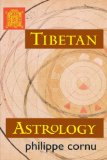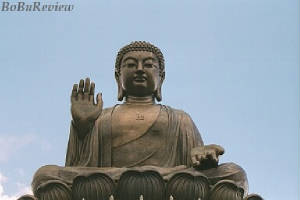The two books
under review this month purport to be about the same general subject of astrology, and both have an Asian perspective, yet
couldn't be more different. For example, Philippe Cornu's book begins with the "The Tibetan science of astrology
has many sources, among which four in particular may be distinguished, the Bon religion, Chinese astrology, Indian
astrology, and the Buddhist Kalachakra Tantra."
Jhampa Shaneman's Preface states that "As a Buddhist
. . . I find karmic connections exist when looking at the planets in the natal chart. The Zodiac is a different matter."
Shaneman, who ordained as a Tibetan Buddhist monk in the 1970's, explains that there is now a discrepancy between
the physical constellations and the zodiac of more than 26 degrees since Ptolemy first set the stage for Western astrology
2,000 years ago. Both books come at astrology from a very different angle than Western "solar" interpretations.
Cornu's astrology is based on
the largely Chinese system of elements and animal signs, which then carries over into some complicated divination systems
of mewas, parkhas, and individual energies that are probably best left for professional astrologers to follow.
However, readers can learn a lot about their own element and animal sign and see which of the others are well-suited
or conflictual.
One of the more pertinent points from "Tibetan Astrology"  is that in the East "the
emphasis is on the fluctuating and impermanent nature of the phenomenal world. The effort to achieve realization is
concerned more with awareness of oneself than with material conquest; and this perhaps explains the choice of a lunar astrology."
In other words, those in the East are generally more concerned with how they fit into the world rather than figuring
out how to dominate it.
is that in the East "the
emphasis is on the fluctuating and impermanent nature of the phenomenal world. The effort to achieve realization is
concerned more with awareness of oneself than with material conquest; and this perhaps explains the choice of a lunar astrology."
In other words, those in the East are generally more concerned with how they fit into the world rather than figuring
out how to dominate it.
Both "Buddhist Astrology" and "Tibetan Astrology" show us where astrology fits
into a Buddhist worldview, although again from slightly different angles. Cornu writes that while astrology is one
of the five "secondary sciences, along with the literary arts," it is also "ubiquitous in the daily life
of the Tibetans and is always combined with religious life."
2.
Jhampa Shaneman devotes a large part of "Buddhist Astrology"
to a fascinating in-depth reading of the Buddha's natal chart, including which planets in which houses could have influenced
him. And yet, a Buddhist view of astrology begins with the fact that "no phenomena, sentient or inanimate, are
separate from the causes and circumstances that create them. Siddhartha is an excellent example of this."
It's just great fun to learn that -- based on the
calculated birth date of May 23, 575 BC -- the Buddha was "most likely a Taurus with Leo rising" (and Scorpio
moon). The placement of planets in his twelve houses were all exceptionally favorable to him becoming The Enlightened
One. (His countless past lives of bodhisattva activity probably didn't hurt, either.) For instance,
the moon in his third house made him inclined "toward subjects focused on emotional relatedness."
Siddhartha's enlightenment "was
not an intellectual journey, but [one] of emotional inquiry." He had to fully understand his own emotions before
he could understand others. His Venus conjunct Uranus meant that he was pre-disposed to feel "spontaneous love
towards others, in combination with a liberal attitude."
Other facets of the Buddha's natal chart were
that his Uranus conjunct Pluto meant that he was able to perform many miracles "because his chi [prana, energy] had
a great deal of power."
 Many more concrete and
explicit examples of the Buddha's birth chart abound in "Buddhist Astrology," which is worth reading for these
gems alone. But Shaneman emphasizes that "No matter what astrological aspects are in a chart, one has the option
to deal with them effectively." He doesn't believe that astrology is rigidly predictive. "It is not
a question of changing the astrological influence; it is one of changing the attitude," or applying skillful means
to any stressful astrological aspects.
Many more concrete and
explicit examples of the Buddha's birth chart abound in "Buddhist Astrology," which is worth reading for these
gems alone. But Shaneman emphasizes that "No matter what astrological aspects are in a chart, one has the option
to deal with them effectively." He doesn't believe that astrology is rigidly predictive. "It is not
a question of changing the astrological influence; it is one of changing the attitude," or applying skillful means
to any stressful astrological aspects.
Cornu's "Tibetan Astrology" is a bit more cut and dried but enormously
insightful as well. Delving into the accuracy of harmonious and inharmonious elements and signs is an eye-opening
experience since the year of birth counts more than the particular month or zodiac sign. While most of us know what
Chinese animal sign ruled the year of our birth, elements are even more important in determining the outcome of relationships.
Wood, metal, fire, and water have complex and dynamic effects on the animal signs -- and each other -- that make for
multi-layered interpretations of compatibility.
3.
It appears we are in an age of astrological renaissance, perhaps due in part to our belated recognition
of the limits of self-determination. Hubris has driven Western civilization far, but also to the brink of extinction.
It's way past time to honor and employ any and all such forms of ancient wisdom in the modern context, in which suffering
is endemic in spite of our technological advances. Astrology can and should be considered, for instance, a modern-day
adjunct to marriage counseling; how could it hurt to know one's given, planetary predilections, as well as one's potential
partner's? Jhampa Shaneman even emphasizes the upsides of stressful astrological influences, while Philippe Cornu
tells us that the Tibetans used many methods to offset negative influences.
"Buddhist Astrology"
points out that astrology can be used "to assist the process of spiritual realization." Particularly in Tibetan
Buddhism, "auspicious dates are used to increase the positive effects of spiritual action," but Jhampa Shaneman
reiterates that our "awareness and wisdom . . . grant freedom from harsh astrological influences."
In arguably one of the more important
sentences in his book, Shaneman states that "the mind and body with mindful awareness receive natural protection from
all hindrances, including astrological." So we shouldn't go around thinking that our fate is written in concrete,
no matter what our stars say. His suggestions on specific Buddhist practices for individual chart themes is particularly
useful. For instance, if your chart indicates a tendency to scattered mental energy or lack of concentration, recommendations
follow as to what specific meditations would be most beneficial.
Astrology used wisely can help guide us to self-knowledge,
both spiritual and mundane. It can help us to pinpoint our strengths and weaknesses, always remembering that our lives
are not precisely predictable because we have free will (within limits). "Everyone is in some part responsible
for how they feel and act in every moment of existence." If personal insight is indeed a crucial component of
the spiritual path, then astrology is one of many tools "to develop deeper and deeper meaning for the individual."

